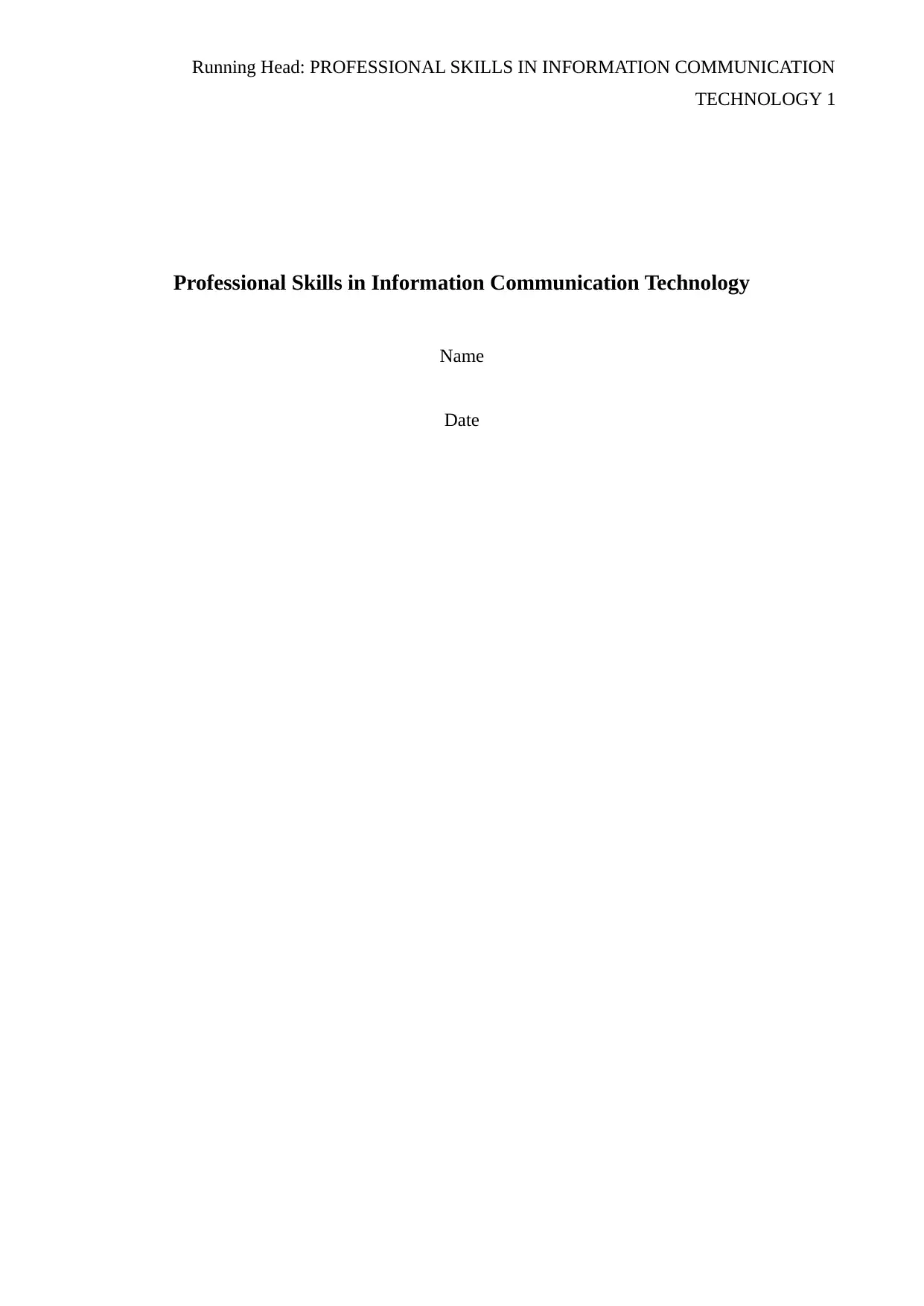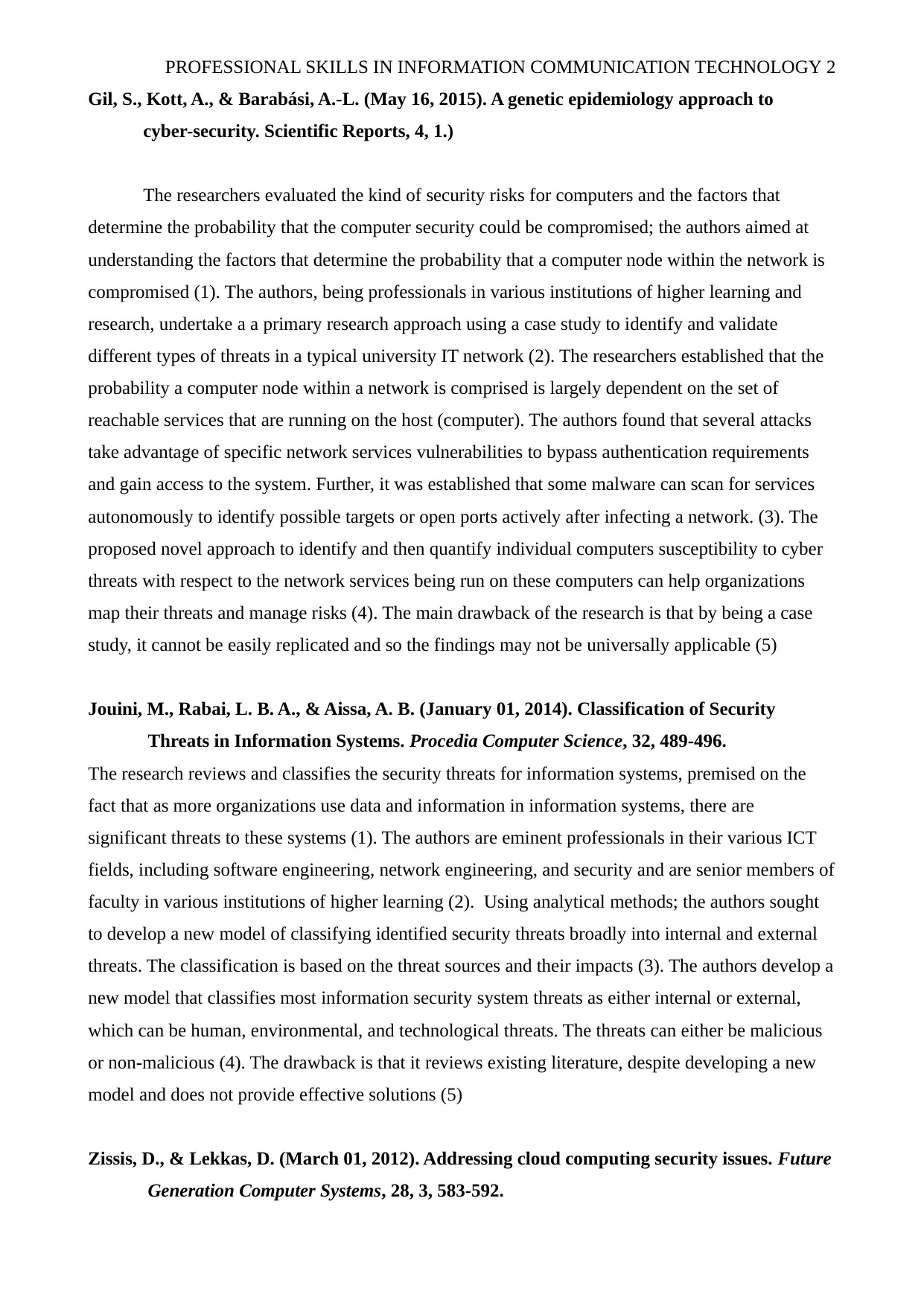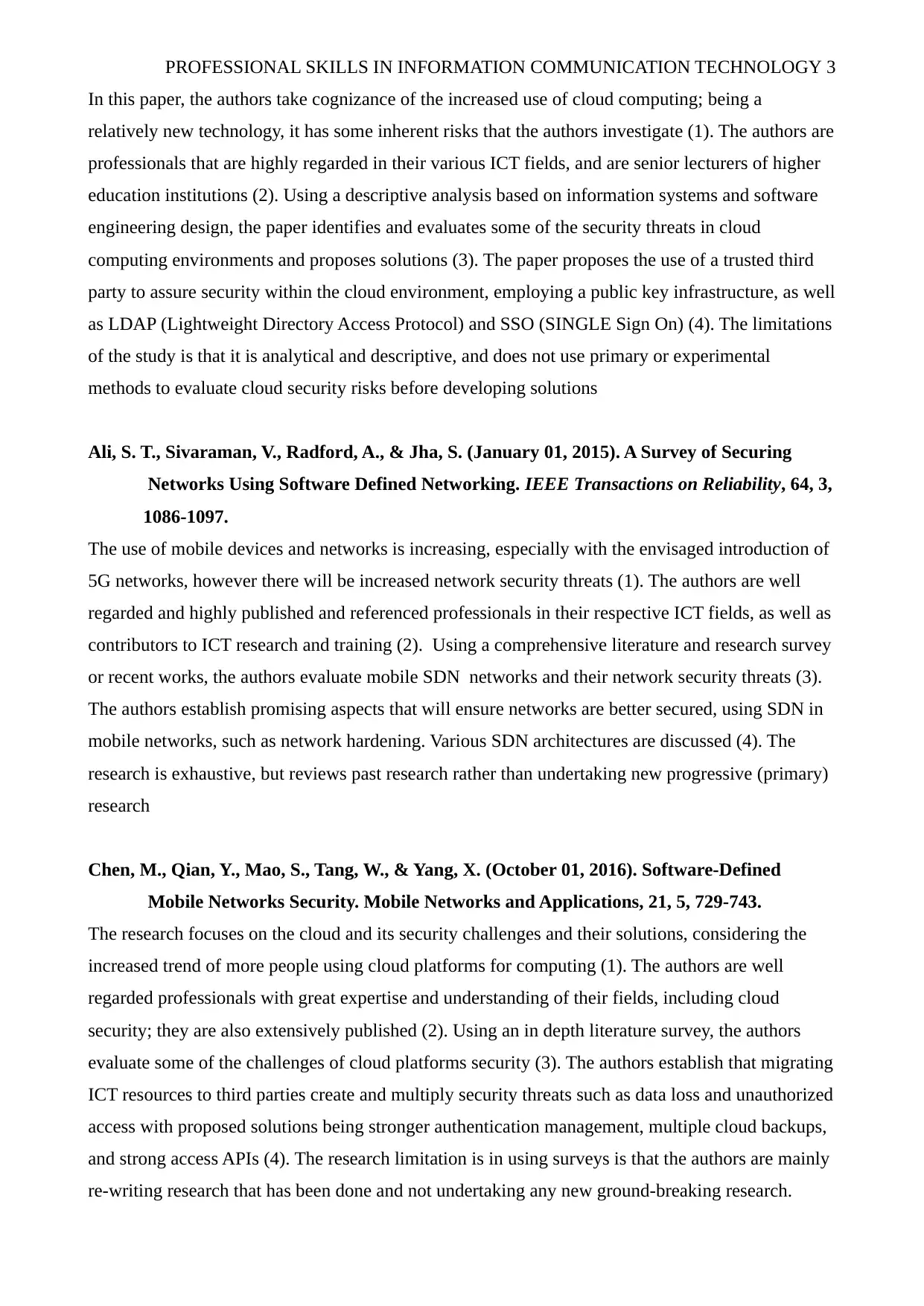Comprehensive Analysis of Cybersecurity Threats in ICT Environments
VerifiedAdded on 2020/02/19
|4
|1090
|38
Report
AI Summary
This report provides a comprehensive overview of cybersecurity threats within the realm of Information and Communication Technology (ICT). It examines various research papers that delve into different aspects of cybersecurity, including network vulnerabilities, cloud computing security, and software-defined networking (SDN). The analysis covers the factors influencing computer security compromises, the classification of security threats in information systems, and the proposed solutions to mitigate these risks. The report highlights the importance of understanding network services vulnerabilities, the use of trusted third parties for cloud security, and the application of SDN for enhanced network security. It also discusses the limitations of the reviewed research, such as the reliance on case studies and literature surveys rather than primary research. Overall, the report aims to provide insights into the current landscape of cybersecurity threats and potential solutions to safeguard ICT systems and networks.

Running Head: PROFESSIONAL SKILLS IN INFORMATION COMMUNICATION
TECHNOLOGY 1
Professional Skills in Information Communication Technology
Name
Date
TECHNOLOGY 1
Professional Skills in Information Communication Technology
Name
Date
Paraphrase This Document
Need a fresh take? Get an instant paraphrase of this document with our AI Paraphraser

PROFESSIONAL SKILLS IN INFORMATION COMMUNICATION TECHNOLOGY 2
Gil, S., Kott, A., & Barabási, A.-L. (May 16, 2015). A genetic epidemiology approach to
cyber-security. Scientific Reports, 4, 1.)
The researchers evaluated the kind of security risks for computers and the factors that
determine the probability that the computer security could be compromised; the authors aimed at
understanding the factors that determine the probability that a computer node within the network is
compromised (1). The authors, being professionals in various institutions of higher learning and
research, undertake a a primary research approach using a case study to identify and validate
different types of threats in a typical university IT network (2). The researchers established that the
probability a computer node within a network is comprised is largely dependent on the set of
reachable services that are running on the host (computer). The authors found that several attacks
take advantage of specific network services vulnerabilities to bypass authentication requirements
and gain access to the system. Further, it was established that some malware can scan for services
autonomously to identify possible targets or open ports actively after infecting a network. (3). The
proposed novel approach to identify and then quantify individual computers susceptibility to cyber
threats with respect to the network services being run on these computers can help organizations
map their threats and manage risks (4). The main drawback of the research is that by being a case
study, it cannot be easily replicated and so the findings may not be universally applicable (5)
Jouini, M., Rabai, L. B. A., & Aissa, A. B. (January 01, 2014). Classification of Security
Threats in Information Systems. Procedia Computer Science, 32, 489-496.
The research reviews and classifies the security threats for information systems, premised on the
fact that as more organizations use data and information in information systems, there are
significant threats to these systems (1). The authors are eminent professionals in their various ICT
fields, including software engineering, network engineering, and security and are senior members of
faculty in various institutions of higher learning (2). Using analytical methods; the authors sought
to develop a new model of classifying identified security threats broadly into internal and external
threats. The classification is based on the threat sources and their impacts (3). The authors develop a
new model that classifies most information security system threats as either internal or external,
which can be human, environmental, and technological threats. The threats can either be malicious
or non-malicious (4). The drawback is that it reviews existing literature, despite developing a new
model and does not provide effective solutions (5)
Zissis, D., & Lekkas, D. (March 01, 2012). Addressing cloud computing security issues. Future
Generation Computer Systems, 28, 3, 583-592.
Gil, S., Kott, A., & Barabási, A.-L. (May 16, 2015). A genetic epidemiology approach to
cyber-security. Scientific Reports, 4, 1.)
The researchers evaluated the kind of security risks for computers and the factors that
determine the probability that the computer security could be compromised; the authors aimed at
understanding the factors that determine the probability that a computer node within the network is
compromised (1). The authors, being professionals in various institutions of higher learning and
research, undertake a a primary research approach using a case study to identify and validate
different types of threats in a typical university IT network (2). The researchers established that the
probability a computer node within a network is comprised is largely dependent on the set of
reachable services that are running on the host (computer). The authors found that several attacks
take advantage of specific network services vulnerabilities to bypass authentication requirements
and gain access to the system. Further, it was established that some malware can scan for services
autonomously to identify possible targets or open ports actively after infecting a network. (3). The
proposed novel approach to identify and then quantify individual computers susceptibility to cyber
threats with respect to the network services being run on these computers can help organizations
map their threats and manage risks (4). The main drawback of the research is that by being a case
study, it cannot be easily replicated and so the findings may not be universally applicable (5)
Jouini, M., Rabai, L. B. A., & Aissa, A. B. (January 01, 2014). Classification of Security
Threats in Information Systems. Procedia Computer Science, 32, 489-496.
The research reviews and classifies the security threats for information systems, premised on the
fact that as more organizations use data and information in information systems, there are
significant threats to these systems (1). The authors are eminent professionals in their various ICT
fields, including software engineering, network engineering, and security and are senior members of
faculty in various institutions of higher learning (2). Using analytical methods; the authors sought
to develop a new model of classifying identified security threats broadly into internal and external
threats. The classification is based on the threat sources and their impacts (3). The authors develop a
new model that classifies most information security system threats as either internal or external,
which can be human, environmental, and technological threats. The threats can either be malicious
or non-malicious (4). The drawback is that it reviews existing literature, despite developing a new
model and does not provide effective solutions (5)
Zissis, D., & Lekkas, D. (March 01, 2012). Addressing cloud computing security issues. Future
Generation Computer Systems, 28, 3, 583-592.

PROFESSIONAL SKILLS IN INFORMATION COMMUNICATION TECHNOLOGY 3
In this paper, the authors take cognizance of the increased use of cloud computing; being a
relatively new technology, it has some inherent risks that the authors investigate (1). The authors are
professionals that are highly regarded in their various ICT fields, and are senior lecturers of higher
education institutions (2). Using a descriptive analysis based on information systems and software
engineering design, the paper identifies and evaluates some of the security threats in cloud
computing environments and proposes solutions (3). The paper proposes the use of a trusted third
party to assure security within the cloud environment, employing a public key infrastructure, as well
as LDAP (Lightweight Directory Access Protocol) and SSO (SINGLE Sign On) (4). The limitations
of the study is that it is analytical and descriptive, and does not use primary or experimental
methods to evaluate cloud security risks before developing solutions
Ali, S. T., Sivaraman, V., Radford, A., & Jha, S. (January 01, 2015). A Survey of Securing
Networks Using Software Defined Networking. IEEE Transactions on Reliability, 64, 3,
1086-1097.
The use of mobile devices and networks is increasing, especially with the envisaged introduction of
5G networks, however there will be increased network security threats (1). The authors are well
regarded and highly published and referenced professionals in their respective ICT fields, as well as
contributors to ICT research and training (2). Using a comprehensive literature and research survey
or recent works, the authors evaluate mobile SDN networks and their network security threats (3).
The authors establish promising aspects that will ensure networks are better secured, using SDN in
mobile networks, such as network hardening. Various SDN architectures are discussed (4). The
research is exhaustive, but reviews past research rather than undertaking new progressive (primary)
research
Chen, M., Qian, Y., Mao, S., Tang, W., & Yang, X. (October 01, 2016). Software-Defined
Mobile Networks Security. Mobile Networks and Applications, 21, 5, 729-743.
The research focuses on the cloud and its security challenges and their solutions, considering the
increased trend of more people using cloud platforms for computing (1). The authors are well
regarded professionals with great expertise and understanding of their fields, including cloud
security; they are also extensively published (2). Using an in depth literature survey, the authors
evaluate some of the challenges of cloud platforms security (3). The authors establish that migrating
ICT resources to third parties create and multiply security threats such as data loss and unauthorized
access with proposed solutions being stronger authentication management, multiple cloud backups,
and strong access APIs (4). The research limitation is in using surveys is that the authors are mainly
re-writing research that has been done and not undertaking any new ground-breaking research.
In this paper, the authors take cognizance of the increased use of cloud computing; being a
relatively new technology, it has some inherent risks that the authors investigate (1). The authors are
professionals that are highly regarded in their various ICT fields, and are senior lecturers of higher
education institutions (2). Using a descriptive analysis based on information systems and software
engineering design, the paper identifies and evaluates some of the security threats in cloud
computing environments and proposes solutions (3). The paper proposes the use of a trusted third
party to assure security within the cloud environment, employing a public key infrastructure, as well
as LDAP (Lightweight Directory Access Protocol) and SSO (SINGLE Sign On) (4). The limitations
of the study is that it is analytical and descriptive, and does not use primary or experimental
methods to evaluate cloud security risks before developing solutions
Ali, S. T., Sivaraman, V., Radford, A., & Jha, S. (January 01, 2015). A Survey of Securing
Networks Using Software Defined Networking. IEEE Transactions on Reliability, 64, 3,
1086-1097.
The use of mobile devices and networks is increasing, especially with the envisaged introduction of
5G networks, however there will be increased network security threats (1). The authors are well
regarded and highly published and referenced professionals in their respective ICT fields, as well as
contributors to ICT research and training (2). Using a comprehensive literature and research survey
or recent works, the authors evaluate mobile SDN networks and their network security threats (3).
The authors establish promising aspects that will ensure networks are better secured, using SDN in
mobile networks, such as network hardening. Various SDN architectures are discussed (4). The
research is exhaustive, but reviews past research rather than undertaking new progressive (primary)
research
Chen, M., Qian, Y., Mao, S., Tang, W., & Yang, X. (October 01, 2016). Software-Defined
Mobile Networks Security. Mobile Networks and Applications, 21, 5, 729-743.
The research focuses on the cloud and its security challenges and their solutions, considering the
increased trend of more people using cloud platforms for computing (1). The authors are well
regarded professionals with great expertise and understanding of their fields, including cloud
security; they are also extensively published (2). Using an in depth literature survey, the authors
evaluate some of the challenges of cloud platforms security (3). The authors establish that migrating
ICT resources to third parties create and multiply security threats such as data loss and unauthorized
access with proposed solutions being stronger authentication management, multiple cloud backups,
and strong access APIs (4). The research limitation is in using surveys is that the authors are mainly
re-writing research that has been done and not undertaking any new ground-breaking research.
⊘ This is a preview!⊘
Do you want full access?
Subscribe today to unlock all pages.

Trusted by 1+ million students worldwide

PROFESSIONAL SKILLS IN INFORMATION COMMUNICATION TECHNOLOGY 4
1 out of 4
Related Documents
Your All-in-One AI-Powered Toolkit for Academic Success.
+13062052269
info@desklib.com
Available 24*7 on WhatsApp / Email
![[object Object]](/_next/static/media/star-bottom.7253800d.svg)
Unlock your academic potential
Copyright © 2020–2025 A2Z Services. All Rights Reserved. Developed and managed by ZUCOL.





